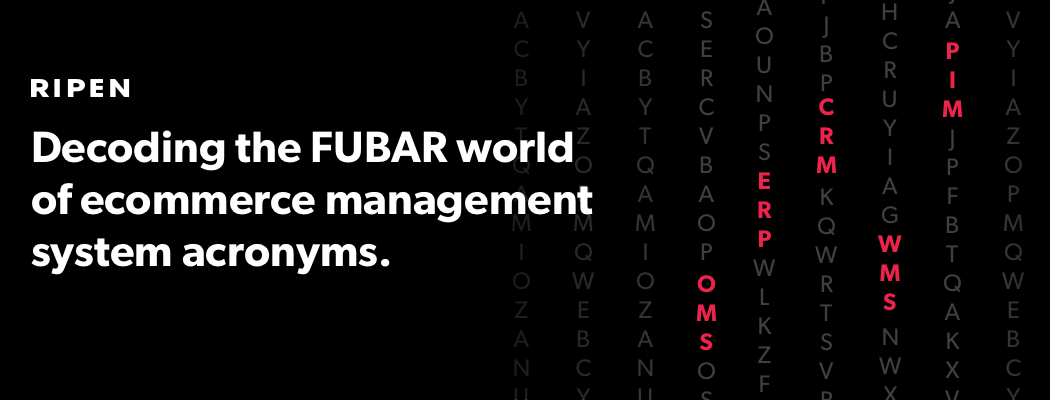Decoding the FUBAR world of ecommerce management system acronyms

Consultant: “So do you want your product data coming from your ERP, your PIM, your DAM, or your CMS? And for orders, do you need an OMS or WMS in addition to the ERP?”
Retailer: “Uh…I just want to sell my products online and make sure everything runs smoothly. Why do I need this alphabet soup!?”
Ecommerce has gotten more and more complicated over the past two decades, and many of these technologies are moving down from the large enterprise into small and mid-size businesses too. Making the situation more complex, many of these technologies overlap to some degree, and one is often added as a side feature to another (for example, many PIMs also function as DAMs, and most ERPs have some sort of OMS function). It gets confusing!
This is the first in a series of guides to help simplify these technologies. Each of these acronyms represents a specific function for the effective operation of your ecommerce business. Modern ecommerce generates data left and right, and these systems help keep it all organized and flowing where it needs to go. But based on your business model and scale, you will likely need some systems and not others. In order to make sense of what you need, it’s good to start with a clear understanding of each system’s contribution. In this article I define each acronym and explain how these systems can help you better manage your growing ecommerce business.
ERP – Enterprise Resource Planning
If information is the lifeblood of a thriving business, then an ERP system is the heart. An ERP system helps a company collect and process just about every type of data that runs through a business, including customer profiles, sales orders, inventory levels, accounting records, and upstream supply chains. ERP software is designed to integrate data from multiple systems and departments into a single, standardized view, so it typically acts as the hub that all other systems connect to. Ultimately, it can help your business make smarter, more data-informed decisions.
Important things you can do with an ERP system:
- Manage customer accounts
- Process orders
- Track manufacturing and supply chains
- Raise alerts when issues arise
- Manage benefits, payroll and employee data
- Manage hiring processes
- View business operation data in real time
- Coordinate company-wide business strategies
- Drive real-time per-customer pricing online with an integration
CRM – Customer Relationship Management
Keeping customers happy and loyal is the primary function of a Customer Relationship Management (CRM) system. It helps you achieve this by recording and storing every customer interaction across multiple contacts and channels. The data it collects allows your marketing or customer success departments to tailor their communication to existing and prospective customers. Companies can organize and segment all aspects of the customer experience with the right CRM system. Its ability to target the right information to the right prospects leads to improved customer experience and higher sales volume.
Important things you can do with a CRM system:
- Automate marketing campaigns
- Provide “best in class” customer service
- Analyze purchase patterns
- Track leads across a sales funnel
- Automate redundant functions
OMS – Order Management System
The way customers make purchases has been forever changed by the internet and digital technology. Consumers want to buy anywhere, fulfill anywhere and return anywhere. Fulfillment operations need to make use of digital technology as well. Getting a product from shopping cart to front porch with perfection is the function of a good Order Management System (OMS). This process can be fraught with challenges from aligning inventory and orders across multiple channels, to making complex decisions about shipping carriers and rates, to tracking fulfillment with third-party logistics. As sales increase in volume, outdated labor-intensive processes like tracking your orders and inventory with spreadsheets or even an ecommerce platform’s built-in tools no longer hold up. A good OMS helps a business track orders, inventory and fulfillment. Modern order management systems allow the automation of internal processes from order to fulfillment leading to happy customers and incremental sales growth.
Important things you can do with a good OMS:
- Process orders and payments regardless of channel
- Update inventory levels
- Route orders from warehouse to destination
- Track orders for customer service teams & customers
- Provide data for forecasting stock levels
- Integrate with accounts receivable to generate invoices and capture online payments
WMS – Warehouse Management System
Consumer expectations for flawless order processing and delivery are very high and an inefficient, slow or mistake-prone system is the fastest way to failure. A Warehouse Management System (WMS) is software designed to improve the efficiency of tracking inventory on its journey into, through and out of a warehouse. Receiving, picking, packing and shipping all become quicker and more accurate with a good WMS.
Important benefits of a good WMS:
- Improved pick-and-pack efficiency
- Automated shipping label generation
- Location-specific receiving so you know where every item is stored
- Clear reporting on fulfillment speed & accuracy
- Accurate inventory tracking with barcoding or other scanning systems
- Optimization of workloads and bin space
PIM – Product Information Management
A Product Information Management (PIM) system creates a centralized system that stores all product-related data and information required for their promotion and sale. The PIM system makes it easy to share product specifications across sales and marketing channels so that there is one place to update product data, from which it is then automatically pushed everywhere those products are sold. Thus, a PIM system is particularly helpful in managing large numbers of SKUs or in industries where product data is updated frequently.
Important things you can do with a PIM:
- Respond quickly to market changes
- Easily add new products
- Update product features in one place
- Ensure a consistent brand experience across multiple sales channels
DAM – Digital Asset Management
A Digital Asset Management (DAM) system stores and facilitates sharing of digital assets like videos, images, logos, spec/sell sheets and more. This efficient sharing can increase the value of your digital assets by easing access and use. In ecommerce a centralized digital asset database is critical to achieving product and brand consistency by providing shoppers with the best quality, most updated visual content available. In addition, for companies with large catalogs, a DAM system can save hundreds of hours of work transforming visual content to meet the unique requirements of each online end point where your content is published. For example, Walmart has different image spec requirements than Amazon, and a DAM can help scale, crop and organize these different versions. DAMs help ecommerce businesses thrive by making it easy to store, organize, access, transform and distribute visual assets.
Important things you can do with DAM:
- Easily access and distribute digital assets
- Improve brand consistency
- Manage copyrights and licensing
- Streamline marketing efforts
Congratulations! You’ve made it into the technical jargon insiders’ club. Now that you have an overview of the distinct roles these systems serve, you can better understand how they might help your company. In the next article in the series I will cover which systems make the most sense for businesses in various industries and at various stages of growth.
If you’re looking for how to utilize these systems for your organization, we can help out with the ecommerce strategy. We are both a Magento and Shopify Agency and capable of handling any one of these integrations end-to-end.
Let’s get started.
Find out how we can help your ecommerce strategy.
Get in touch
If you’re a rockstar with big ideas, join our team.
